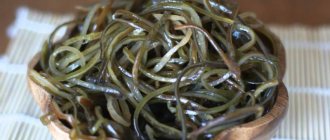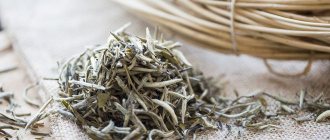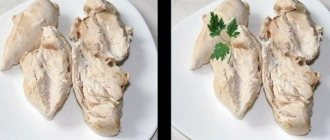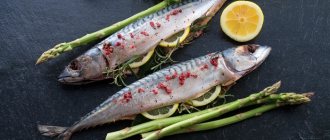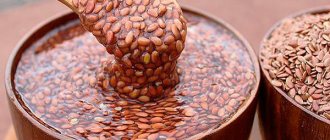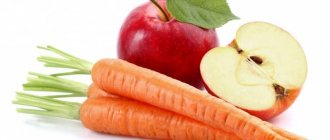Savoy cabbage is a vegetable crop that is part of the Cruciferous family of the cabbage genus. The wild ancestor has not yet been identified, although there is a theory that the first wild species were found in Colchis, in the territory of modern Georgia. Peasants from the Italian county of Savoy were the first to cultivate the Savoy variety, which is why the crop received its name. The heads are similar to white cabbage, but the ruffled, dark green leaves do not have rough veins and are milder in taste and sweeter. In its raw form, the variety is widely used by culinary specialists in the USA and Western Europe.
Composition and calorie content of savoy cabbage
The energy value of Savoy cabbage is low, so it can be safely introduced into the diet when losing weight or constantly monitoring its changes.
The calorie content of savoy cabbage per 100 g of product is 28.2 kcal, of which:
- Proteins - 1.2 g;
- Fats - 0.1 g;
- Carbohydrates - 6 g;
- Dietary fiber - 0.5 g;
- Water - 90 g;
- Ash - 0.1 g.
Vitamins per 100 g:
- Vitamin A, RE - 3.3333 mcg;
- Beta Carotene - 0.02 mg;
- Vitamin B1, thiamine - 0.04 mg;
- Vitamin B2, riboflavin - 0.05 mg;
- Vitamin B6, pyridoxine - 0.2 mg;
- Vitamin B9, folate - 18.5 mcg;
- Vitamin C, ascorbic acid - 5 mg;
- Vitamin RR, NE - 0.7992 mg;
- Niacin - 0.6 mg.
Macroelements per 100 g:
- Potassium, K - 238 mg;
- Calcium, Ca - 15 mg;
- Magnesium, Mg - 9 mg;
- Sodium, Na - 20 mg;
- Sulfur, S - 15 mg;
- Phosphorus, Ph - 34 mg;
- Chlorine, Cl - 47 mg.
Microelements per 100 g:
- Aluminum, Al - 815 μg;
- Boron, B - 100 μg;
- Iron, Fe - 0.4 mg;
- Iodine, I - 2 μg;
- Cobalt, Co - 1 μg;
- Manganese, Mn - 0.21 mg;
- Copper, Cu - 135 μg;
- Molybdenum, Mo - 10 μg;
- Fluorine, F - 14 μg;
- Zinc, Zn - 0.29 mg;
Digestible carbohydrates per 100 g of product:
- Starch and dextrins - 0.5 g;
- Mono- and disaccharides (sugars) - 5 g.
Savoy cabbage contains antioxidants, phytoncides, acids and amino acid complexes.
The main beneficial properties of Savoy cabbage are due to the following substances:
- Ascorbic acid improves immunity, increases iron absorption, and participates in the body's redox processes.
- Potassium ensures water-salt metabolism, stabilizes heart rhythm, and prevents the development of tachycardia.
- Molybdenum accelerates metabolic processes, stimulates the synthesis of enzymes that ensure the removal of purines, sulfur-containing amino acids and pyrimidines.
- Aluminum is involved in the construction of bone and connective tissue, the formation of epithelium, and inhibits age-related changes.
Savoy cabbage juice improves immunity and is successfully used to combat obesity.
Savoy cabbage is relatively high in protein and low in dietary fiber, so it is recommended to include it in the diet during increased exercise.
Benefits of cabbage juice
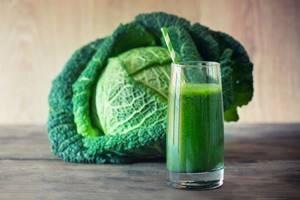
If you drink it in its pure form, you can cope with gastritis, characterized by low acidity of gastric juice . On the topic:
How to effectively fight clubroot on cabbage using...
Juicy Chinese cabbage pak choi for real gourmets
Red pickled cabbage for the winter - recipes with...
Which type of cabbage is best for pickling, so that the dish...
BACK FORWARD 1 of 16
The juice is widely used for the treatment of oral diseases. It is mixed in equal proportions with water. The resulting liquid is used to rinse the mouth for periodontal disease and stomatitis. It will also help cope with a sore throat, as it has antiseptic properties.
Savoy cabbage juice has whitening and rejuvenating properties. It is often used to make lotions and face creams. An excellent remedy for problem skin can be prepared by mixing 50 ml of juice, 25 ml of salicylic alcohol and 25 ml of clean water. Use the resulting mixture to wipe your face in the morning and before bed.
Beneficial properties of savoy cabbage
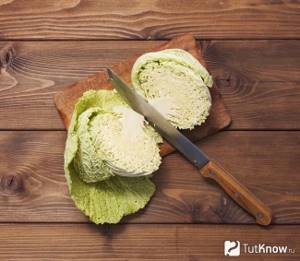
They try to include it in the daily menu during the epidemic season and during rehabilitation after diseases that cause depletion of the body. The benefits of savoy cabbage and dishes in which it is one of the main components:
- Strengthens the immune system due to the high content of vitamin C (ascorbic acid).
- Promotes the functioning of the circulatory system, stabilizes blood pressure and has a beneficial effect on the nervous system.
- It has a diuretic effect and prevents the development of edema.
- Activates intestinal function and improves digestion, accelerates the removal of toxins from the body.
- It has an antioxidant effect due to its high chlorine content, which accelerates the absorption of vitamin B12.
- Slows down cell aging due to the high content of glutathione, an amino acid complex.
- Normalizes blood glucose levels and stops the development of diabetes due to mannitol alcohol in the composition.
- Fights obesity thanks to tartronic acid, which prevents the formation of fatty deposits from carbohydrates supplied with food.
- Blocks changes in DNA structures, stops malignancy, and prevents the degeneration of cells of existing tumors.
With elevated progesterone levels and heavy menstruation, savoy cabbage salads should be included in the diet up to 4-5 times a week.
Savoy cabbage is very healthy for men. It prevents the development of prostatitis, increases libido, and restores sexual function.
Savoy cabbage is easily digestible, so it is recommended to include it in the diet of young children, the elderly and pregnant women. The vegetable contains folic acid, which stimulates the production of enzymes for carbon metabolism and is involved in the formation of new cells.
Does it help you lose weight?
Savoy cabbage leaves are an excellent dietary product that helps you lose excess weight. The benefits of vegetables for weight loss are due to its properties:
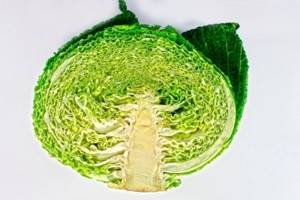
- reduces the digestibility of carbohydrates, gives a feeling of satiety;
- cleanses the intestines;
- removes excess fluid from the body;
- Tartronic acid in the vegetable slows down the absorption of sugars and prevents surges in blood glucose.
Heads of cabbage contain a minimal amount of essential oils and do not whet the appetite. On the contrary, savoy cabbage gives a long-lasting feeling of fullness and dulls the feeling of hunger.
Cabbage is considered a product with negative calorie content , that is, the body spends more energy digesting it than it can receive. Savoy cabbage not only does not increase the calorie content of the diet, but also reduces the amount of calories obtained from food.
Only fresh vegetables will benefit you when losing weight. It is best to eat the leaves as part of a vegetable salad with a small amount of vegetable oil.
Harm and contraindications to eating savoy cabbage

The following diseases are contraindications to savoy cabbage in the diet:
- Chronic pancreatitis. Savoy cabbage stimulates the production of enzymes, increasing the load on the organ.
- For gastritis with high acidity. The high content of ascorbic acid increases the secretion of digestive juice, which contains hydrochloric acid.
- With exacerbation of enterocolitis, peptic ulcer of the stomach and duodenum.
- If there is a malfunction of the thyroid gland. The pulp of the leaves has a high iodine content, which can destabilize the production of thyroid hormones.
- If you are prone to diarrhea, stimulation of peristalsis aggravates the condition.
Savoy cabbage should not be included in the diet after surgery on the abdominal cavity and chest area. An increase in the amount of intestinal gases causes spastic contractions of the intestines, an increase in intra-abdominal pressure, which can provoke separation of postoperative sutures.
What can be replaced?
Savoy cabbage in a dish can be replaced with other types of cabbage:
- white cabbage;
- red cabbage;
- Beijing;
- kohlrabi;
- leafy
As an alternative for fresh salads and vegetable juices, you can use cauliflower, Brussels sprouts, and broccoli.
The culture is very valuable for the health of adults and children , however, before introducing a new product into the diet, you should make sure that there are no contraindications, and also follow the consumption standards.
Recipes with savoy cabbage
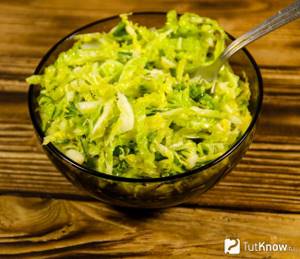
For salads, you should choose large heads of cabbage - they are more juicy, and for hot dishes they are dense, medium in size. Recipes with Savoy cabbage:
- Fresh savoy cabbage salad
. Chop a small head of Savoy cabbage, add 2-3 red apples without peel, cut into strips, one onion and grated horseradish. Add salt and season with the juice of 1 lemon and corn oil to taste. - Savoy cabbage salad with nuts
. Finely chop the cabbage, mash to release juice, simmer without adding oil for 5-7 minutes over low heat. Crush about a third of a glass of walnuts and 2 garlic cloves, mix, add the lemon juice of 1 lemon, pepper and salt. Heat the corn or sunflower oil and, while it is hot, whisk. Stewed cabbage is mixed with nut dressing and poured with cooled whipped butter. - Stewed savoy cabbage seasoned with garlic
. A medium-sized head of cabbage is finely chopped. Fry garlic in a thick-walled pan - 2 tablespoons of sunflower oil and 3 crushed cloves of garlic. As soon as the garlic is fried and acquires a nutty hue, add shredded cabbage into a container, add salt and, stirring constantly, simmer for 5 minutes. The dish is served hot, with chopped parsley added to each plate. - Savoy cabbage soup
. It is advisable to cook the soup using beef broth, but you can also use chicken broth. Broth - 0.3 l - boil in advance, be sure to skim off the foam so that it does not spoil the delicate taste later. Finely chop 300 g of Savoy cabbage and pour boiling water over it. Then divide the broth into 2 parts, set one aside, and simmer the cabbage in one for 15 minutes, adding oil. After the cabbage is cooked, it is crushed in a blender to a puree-like consistency. Fry flour and butter in a frying pan. Add the remaining broth to the puree soup, put it on the fire, add some salt and bring to a boil. Remove the boiling soup from the heat and season with milk or cream. This dish is served with garlic croutons, seasoned with fresh dill. - Stuffed savoy cabbage
. Ingredients: 0.5 kg of chicken meat, 3 medium heads of Savoy cabbage, 2 onions, 100 g of sour cream, 350 ml of broth, 50 g of butter, a bunch of fresh dill, salt and a mixture of peppers. The broth is cooked in advance. The onion is finely chopped and fried in vegetable oil, then passed through a meat grinder along with chicken, the minced meat is salted and pepper is added. The heads of cabbage are washed and doused with boiling water to make the leaves softer. Carefully remove the stalks to create an even depression in the middle. Heat the oven to 180 degrees, grease the baking sheets with oil. Place minced meat into the heads of cabbage and place them on a baking sheet. Place the baking sheet in the oven and leave for 10 minutes. At this time, prepare the sauce - mix sour cream with broth and add a little salt. Take the baking sheets out of the oven, pour the sauce over the heads of cabbage, and place them back. In total, the dish is prepared for 45-50 minutes. Before serving, sprinkle with chopped dill. - Fish cabbage rolls
. The dish is very healthy, it includes pink salmon and a large number of vegetables: savoy cabbage, onions, bell peppers, tomatoes, carrots, onions. Cabbage rolls are stewed in tomato juice. The whole head of cabbage is placed in salted boiling water and, when the leaves become soft, carefully separated from the stalk. Remove the bones from the pulp of fresh pink salmon and cut it into small even pieces and add some salt. Vegetables - onions, carrots and peppers - are chopped and fried in sunflower oil. Tomatoes are cut into slices. Stuffed cabbage rolls are formed as follows: on each flattened sheet, place 2-3 pieces of fish, a spoonful of fried vegetables and a piece of tomato, and wrap tightly. Place the cabbage rolls in a thick-bottomed pan, pour in tomato juice and place in the oven for 40-50 minutes. Served with sour cream.
The beneficial properties of Savoy cabbage are preserved after heat treatment. But it is not recommended to store dishes in the refrigerator for a long time - it costs only enough to cook to eat during the day.
How to use
Savoy cabbage is commonly used not only in the preparation of various dishes, but also in folk medicine. Let's take a closer look at each of these areas.
In cooking
Let's look at how to eat cabbage. This vegetable can be consumed not only raw, but also after heat treatment. Cabbage leaves are perfect for making cabbage rolls and various salads, and when boiled, it can act as both a side dish and a first course.
Did you know? A resident of St. Petersburg, Efim Grachev, managed to grow cabbage with a diameter of 71 cm. The vegetable was demonstrated in 1873 at an exhibition in Vienna.
It is often used as a filling for making pies and casseroles. Due to its hard leaves, it cannot be used for sourdough.
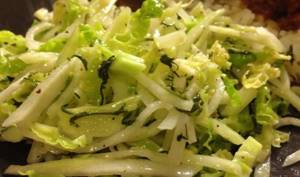
In folk medicine
The vegetable is used in folk medicine and cosmetology.
Let's take a closer look at the medicinal properties of Savoy cabbage and some of the simplest and most effective recipes for use:
- Drinking 150 g of freshly squeezed juice twice daily will help get rid of vitamin deficiency.
- For burns, lightly squeezed cabbage leaves should be applied to the wound.
Stuffed with meat
The fillet in the cabbage turns out juicy, and thanks to the cheese and mushrooms the dish acquires a unique taste.
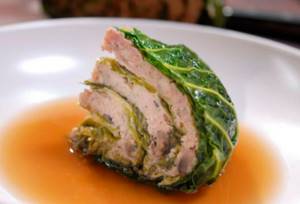
Ingredients:
- cabbage – head of savoy;
- chicken fillet – 570 g;
- cheese – 210 g hard;
- champignons – 320 g;
- mushrooms – 12 g dry;
- broth – 470 ml;
- onions – 2 pcs.;
- oil – 35 ml vegetable;
- sugar – 5 g;
- cream – 75 ml fat;
- garlic – 3 cloves;
- egg – 2 pcs. chicken;
- salt;
- wine – 110 ml dry white;
- marjoram – 1 teaspoon;
- flour – 2 tbsp. spoons;
- nutmeg – 2 teaspoons;
- oregano – 3 teaspoons dried;
- pepper.
